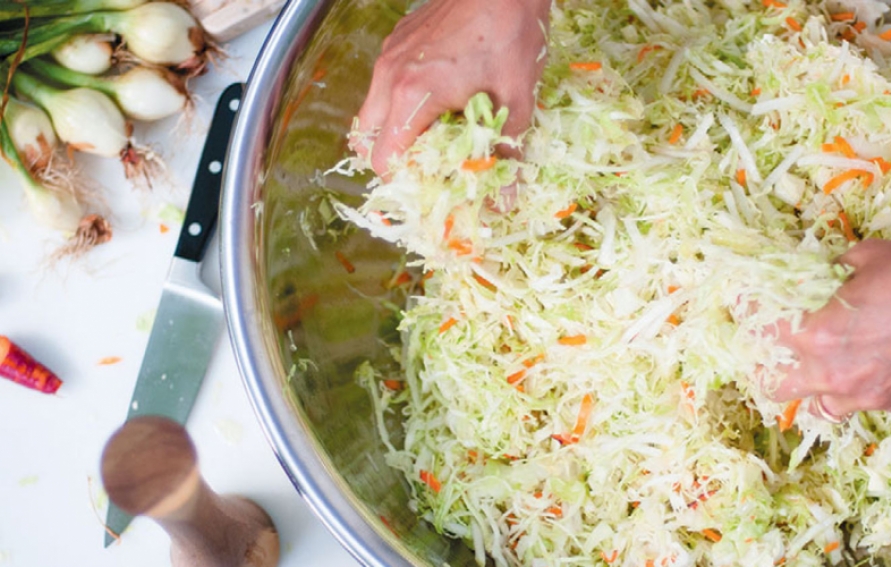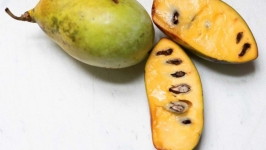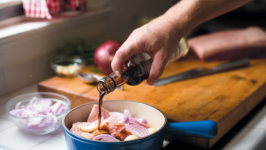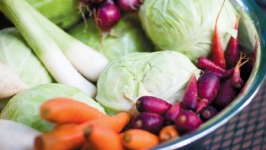Ingredients
- 5 to 6 pounds of red and/or green cabbage (2–3 medium heads)
- Fine ground sea salt (approximately 1–3 tablespoon)—more needed in the warmer months, less in cooler months
- Any other seasonal vegetables—ginger, garlic and onion, beets, carrots, daikon
- Optional: herbs and spices like caraway seeds, dill seed or juniper berries
- Small amount of fruit (apple or pear)
Instructions
Prepping and Seasoning the Vegetables
Slice cabbage in half lengthwise, so that the stem keeps each half together. Shred all cabbage into ¼-inch ribbons using a mandolin, chef’s knife or any tool that works for you, discarding the stem.
Combine shredded cabbage into a large mixing bowl. In layers, sprinkle salt throughout cabbage. Let sit while chopping the remaining vegetables. Brine will form as salt draws water from the cabbage.
Chop remaining vegetables to a size of your choice. Shredding creates a different texture than chopping. Experiment with different sizes.
Add any spices to the cabbage and vegetable mixture.
With clean hands, begin squeezing the cabbage to bruise the surface of the vegetables and speed the release of water from the cabbage, adding any remaining salt.
Add bruised and squeezed cabbage to 3-quartsize jars or larger wide-mouth glass vessel or ceramic crock.
Pack down contents into your vessel so that the brine is above the surface of the vegetables.
The Fermentation Process
Place a weight (glass jar, plate or other weight) that fits inside the container to weigh down the vegetables and keep them below the brine. Vegetables should be completely submerged when weighted down.
Cover the container with a loose-fitting lid or a tea towel and rubber band to keep out flies and reduce mold and yeast growth.
Place the vessel on a plate (to catch any overflow of brine during the first week of fermentation) and place on the counter in the kitchen to ferment.
After one week, check on the contents, tasting and observing for mold. Scrape off any surface mold and clean the plate or weight. Repack the surface, pushing down the sauerkraut, replacing the plate and weight.
Limit the number of times you expose the surface of the sauerkraut to air as this allows yeast and molds to enter the environment.
The vegetables will begin to ferment within a few days. The length of time to ferment sauerkraut varies and is typically 1–4 weeks. However, as you observe the texture, flavor and feel of the vegetables, taste it and decide when it seems right for you.
In the winter months I may ferment my sauerkraut in a crock for 4–6 weeks. In the summer months it may be to my liking in 1 week.
When you are happy with the flavor put the kraut in containers and store them in the refrigerator. Sauerkraut will keep for several months and continue to age and transform.
Enjoy a forkful or two of sauerkraut with your meals!
Preparation
Equipment:
Cutting board and chef’s knife
Large mixing bowl
Vegetable peeler, grater and measuring spoons
3–4 -quart wide-mouth canning jar
Small weight that fits inside the jar opening – like a 4-ounce “jelly” canning jar
Wide-mouth plastic storage cap (or lid and rim that comes with jar)










